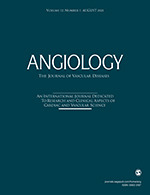Chilli
How to submit an article:
- Registered users can submit any published journal article that has a unique DOI (Digital Object Identifier) name or link to Research Hub.
- For example, you can paste the full DOI link:
https://doi.org/10.1109/5.771073or just the DOI name:10.1109/5.771073into the field above and click submit. - The person who is first to submit a valid article to Research Hub will forever be credited for it, and every article submission earns you +6 Research Points.
Related Topics
Published research studies are articles that present the findings of original research that has undergone a peer-review process and has been made publicly available in scholarly journals, books or other media.

Association of Spicy Chilli Food Consumption With Cardiovascular and All-Cause Mortality: A Meta-Analysis of Prospective Cohort Studies
2021 Mar 4 Angiology Ofori-Asenso R, Mohsenpour MA, Nouri M, Faghih S, Liew D, Mazidi M.
Systematic Review Meta-Analysis Cardiovascular Disease ChilliEpidemiological studies suggest that the consumption of spicy chilli food is associated with reduced risk of all-cause as well as heart disease–related mortality.

Medicinal uses and health benefits of chili pepper (Capsicum spp.) : a review
2018 Jul 5 MOJ Food Processing & Technology Saleh BK, Omer A, Teweldemedhin B.
Systematic ReviewChili pepper has preventive and therapeutic properties for many ailments such as different types of cancer, rheumatism, stiff joints, bronchitis and chest colds with cough and headache, arthritis, heart arrhythmias and used as stomachic.

Harnessing the Therapeutic Potential of Capsaicin and Its Analogues in Pain and Other Diseases
2016 Jul 23 Molecules Basith S, Cui M, Hong S, Choi S
Review Article ChilliPrevious records suggest pleiotropic pharmacological activities of capsaicin such as an analgesic, anti-obesity, anti-pruritic, anti-inflammatory, anti-apoptotic, anti-cancer, anti-oxidant, and neuro-protective functions. Emerging data indicate its clinical significance in treating vascular-related diseases, metabolic syndrome, and gastro-protective effects.
Research insights are moderated by the Research Hub team and offer an at-a-glance overview of interesting research findings.

2021 Angiology
Epidemiological studies suggest that the consumption of spicy chilli food is associated with reduced risk of all-cause as well as heart disease–related mortality.
Systematic Review Cardiovascular Disease
Association of Spicy Chilli Food Consumption With Cardiovascular and All-Cause Mortality: A Meta-Analysis of Prospective Cohort Studies
Ofori-Asenso R, Mohsenpour MA, Nouri M, Faghih S, Liew D, Mazidi M.

2018 MOJ Food Processing & Technology
Chili pepper has preventive and therapeutic properties for many ailments such as different types of cancer, rheumatism, stiff joints, bronchitis and chest colds with cough and headache, arthritis, heart arrhythmias and used as stomachic.
Systematic Review
Medicinal uses and health benefits of chili pepper (Capsicum spp.) : a review
Saleh BK, Omer A, Teweldemedhin B.

2016 Molecules
Previous records suggest pleiotropic pharmacological activities of capsaicin such as an analgesic, anti-obesity, anti-pruritic, anti-inflammatory, anti-apoptotic, anti-cancer, anti-oxidant, and neuro-protective functions. Emerging data indicate its clinical significance in treating vascular-related diseases, metabolic syndrome, and gastro-protective effects.
Review Article
Harnessing the Therapeutic Potential of Capsaicin and Its Analogues in Pain and Other Diseases
Basith S, Cui M, Hong S, Choi S
Review Articles
Review articles summarise and critically evaluate the current state of research on a specific topic or field by synthesising multiple primary research studies.

Association of Spicy Chilli Food Consumption With Cardiovascular and All-Cause Mortality: A Meta-Analysis of Prospective Cohort Studies
2021 Mar 4 Angiology Ofori-Asenso R, Mohsenpour MA, Nouri M, Faghih S, Liew D, Mazidi M.
Systematic Review Meta-Analysis Cardiovascular Disease ChilliEpidemiological studies suggest that the consumption of spicy chilli food is associated with reduced risk of all-cause as well as heart disease–related mortality.

Medicinal uses and health benefits of chili pepper (Capsicum spp.) : a review
2018 Jul 5 MOJ Food Processing & Technology Saleh BK, Omer A, Teweldemedhin B.
Systematic ReviewChili pepper has preventive and therapeutic properties for many ailments such as different types of cancer, rheumatism, stiff joints, bronchitis and chest colds with cough and headache, arthritis, heart arrhythmias and used as stomachic.

Harnessing the Therapeutic Potential of Capsaicin and Its Analogues in Pain and Other Diseases
2016 Jul 23 Molecules Basith S, Cui M, Hong S, Choi S
Review Article ChilliPrevious records suggest pleiotropic pharmacological activities of capsaicin such as an analgesic, anti-obesity, anti-pruritic, anti-inflammatory, anti-apoptotic, anti-cancer, anti-oxidant, and neuro-protective functions. Emerging data indicate its clinical significance in treating vascular-related diseases, metabolic syndrome, and gastro-protective effects.
Clinical Trials
Clinical trials are research studies that involve people and are conducted to evaluate the safety and efficacy of new treatments or interventions, such as drugs, medical devices, or behavioural therapies.
Study Protocols
Published study protocols are detailed plans that outline the objectives, methodology, statistical analyses, and organisation of a research study that have been made publicly available for others to review and use as a reference.
Presentation Slides

Systematic Review
Epidemiological studies suggest that the consumption of spicy chilli food is associated with reduced risk of all-cause as well as heart disease–related mortality.
Ofori-Asenso R, Mohsenpour MA, Nouri M, Faghih S, Liew D, Mazidi M.

Systematic Review
Chili pepper has preventive and therapeutic properties for many ailments such as different types of cancer, rheumatism, stiff joints, bronchitis and chest colds with cough and headache, arthritis, heart arrhythmias and used as stomachic.
Saleh BK, Omer A, Teweldemedhin B.

Review Article
Previous records suggest pleiotropic pharmacological activities of capsaicin such as an analgesic, anti-obesity, anti-pruritic, anti-inflammatory, anti-apoptotic, anti-cancer, anti-oxidant, and neuro-protective functions. Emerging data indicate its clinical significance in treating vascular-related diseases, metabolic syndrome, and gastro-protective effects.
Basith S, Cui M, Hong S, Choi S
Executive Summary
Write an executive summary in the form of a blog article on the topic of "Research into Chinese medicine treatment for Chilli" summarising the research below and using language that can be easily understood by patients and avoiding medical jargon using a professional and caring tone of voice.
Write an executive summary in the form of a blog article on the topic of "Researched Chinese medicine treatments for Chilli" summarising the research below in an objective and easy to understand way, and using language that can be easily understood by patients. Group the article into Chinese medicine treatments first, followed by nutrition and other treatments. Avoid using medical jargon and use a professional and caring tone of voice.
Write me a concise but easy to understand executive summary on the topic of "Chinese medicine treatments for Chilli" based on the following research that I will give you. Your summary should be 2 paragraphs long in Australian English spelling and include references to the studies.
A Systematic Review published in 2021 in the journal Angiology found that Epidemiological studies suggest that the consumption of spicy chilli food is associated with reduced risk of all-cause as well as heart disease–related mortality. This systematic review and meta-analysis examined the association between spicy food (chilli pepper, chilli sauce, or chilli oil) consumption with cardiovascular and all-cause mortality. Medline and EMBASE were searched from their inception until February 2020 to identify relevant prospective cohort studies. Hazard ratios (HRs)/relative risk (RRs) were pooled via random-effect meta-analysis. Of the 4387 citations identified, 4 studies (from the United States, China, Italy, and Iran) were included in the meta-analysis. The included studies involved a total of 564 748 adults (aged ≥18 years; 51.2% female) followed over a median duration of 9.7 years. The pooled data suggested that compared with people who did not regularly consume spicy food (none/<1 d/wk), regular consumers of spicy food experienced a 12% (HR/RRpooled 0.88, 95% CI, 0.86-0.90; I 2 = 0%) lower risk of all-cause mortality. Moreover, spicy food consumption was associated with significant reduction in the risk of death from cardiac diseases (HR/RRpooled 0.82, 0.73-0.91; I 2 = 0%), but not from cerebrovascular disorders (HR/RRpooled 0.79, 0.53-1.17; I 2 = 72.2%). In conclusion, available epidemiological studies suggest that the consumption of spicy chilli food is associated with reduced risk of all-cause as well as heart disease–related mortality. Further studies in different populations are needed to confirm this association.
A Systematic Review published in 2018 in the journal MOJ Food Processing & Technology found that Chili pepper has preventive and therapeutic properties for many ailments such as different types of cancer, rheumatism, stiff joints, bronchitis and chest colds with cough and headache, arthritis, heart arrhythmias and used as stomachic. A vanilloid receptor known as VR1 which was later found to be member of the family TRP and was called TRPV1 (transient receptor potential vanilloid subtype 1) is the receptor for capsaicin and is universally distributed in the brain, sensory nerves, dorsal root ganglia, bladder, gut, and blood vessels. Capsaicin is activate and then desensitize or block VR1 and was found to be powerful drug in animal models of human disease. Capsaicin plays a potential role in cardiometabolic protection through the activation of TRPV1 in different target organs or tissues, which suggests that TRPV1 may be a promising target for the management of cardiometabolic diseases such as obesity, hypertension, dyslipidemia, diabetes and atherosclerosis. However, association between the dosage of dietary capsaicin and the effect on cardiometabolic protection need to be clarified for determining the daily usage or intake of capsaicin or its derivatives. The activation of VR1 by capsaicin make it possible to be involved in various human disease states ranging from genetic pain insensitivity to chronic pain syndromes. In addition to that VR1 has much broader clinical benefits than mere pain case. Chili pepper has preventive and therapeutic properties for many ailments such as different types of cancer, rheumatism, stiff joints, bronchitis and chest colds with cough and headache, arthritis, heart arrhythmias and used as stomachic. Chili preparations for treating ailments can be standard capsaicin, pharmaceutically prepared gels, creams and plasters, essential oils distilled from pods, powder prepared by crashing pods and extracts by soaking pods in water or ethanol.
A Review Article published in 2016 in the journal Molecules found that Previous records suggest pleiotropic pharmacological activities of capsaicin such as an analgesic, anti-obesity, anti-pruritic, anti-inflammatory, anti-apoptotic, anti-cancer, anti-oxidant, and neuro-protective functions. Emerging data indicate its clinical significance in treating vascular-related diseases, metabolic syndrome, and gastro-protective effects. Capsaicin has elicited enormous interest for several centuries due to its conspicuous culinary and clinical applications. Despite its adverse effects, capsaicin is still being used as an active principle in several pharmaceutical formulations for treating various human ailments. Moreover, emerging studies have shown that capsaicin is implicated in a broader range of functions than previously anticipated. Even though it is best characterized in the field of nociception and pain, several experimental and clinical studies also demonstrate its role in other important pathological states like cancer, obesity, skin disorders, cardiovascular diseases, etc. Additionally, it has also been implicated in other activities including treatment of the upper respiratory reflexes, prevention of adipogenesis, boosting metabolic rate, and regulation of innate and adaptive immune responses.
Moderation Tools
Topic
Sign In
Users not signed in are limited to viewing the 5 most recent items of content.